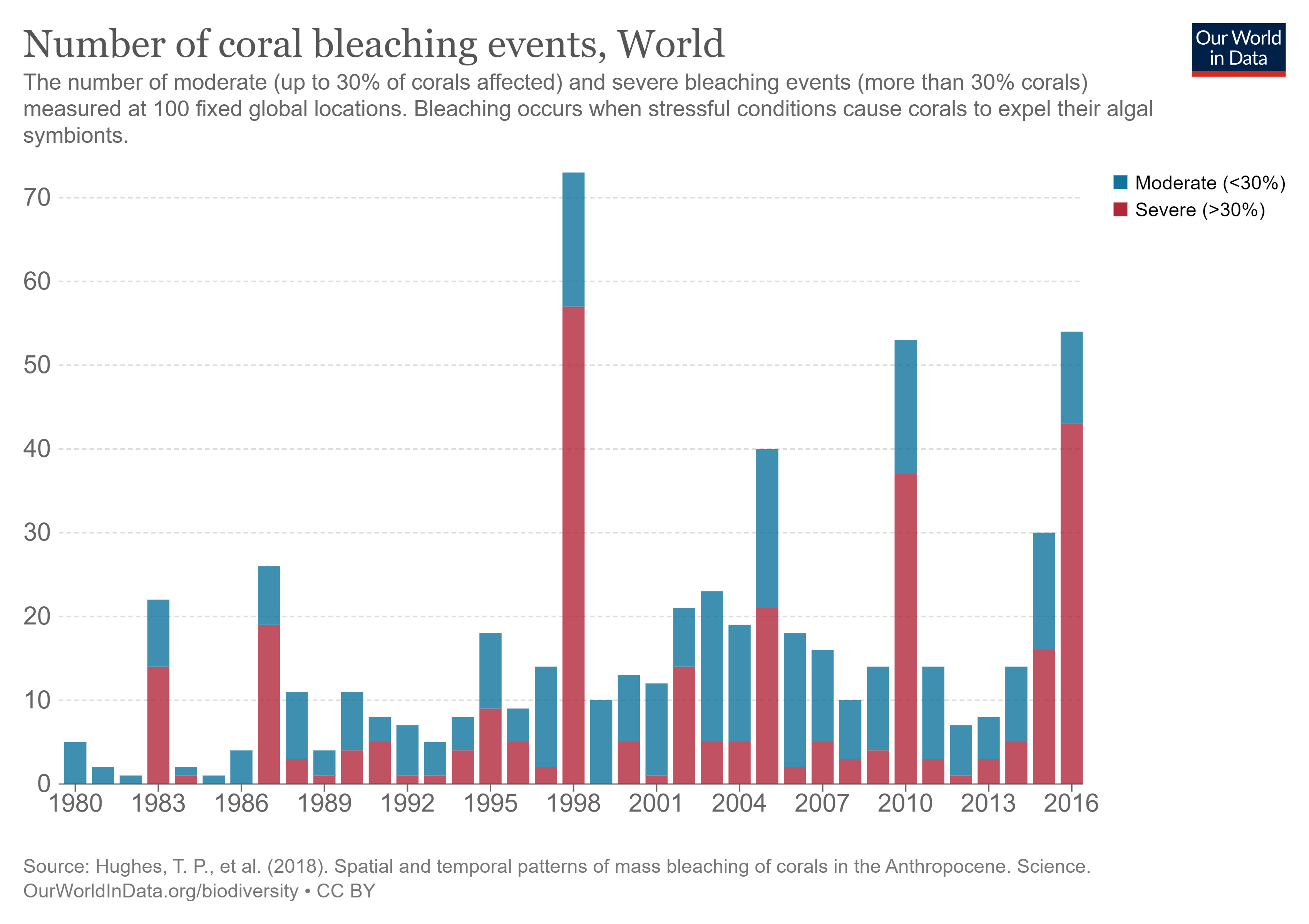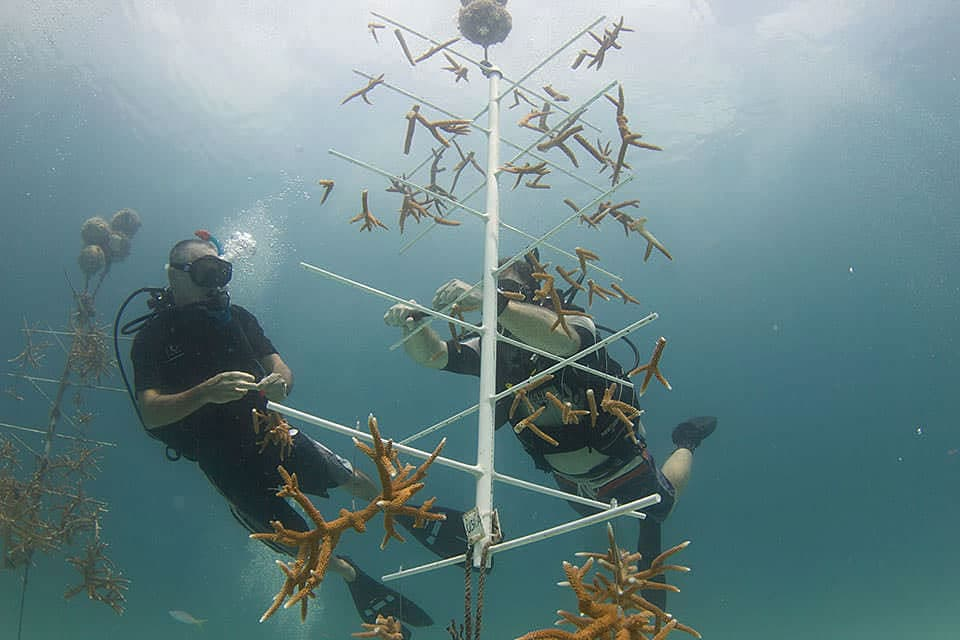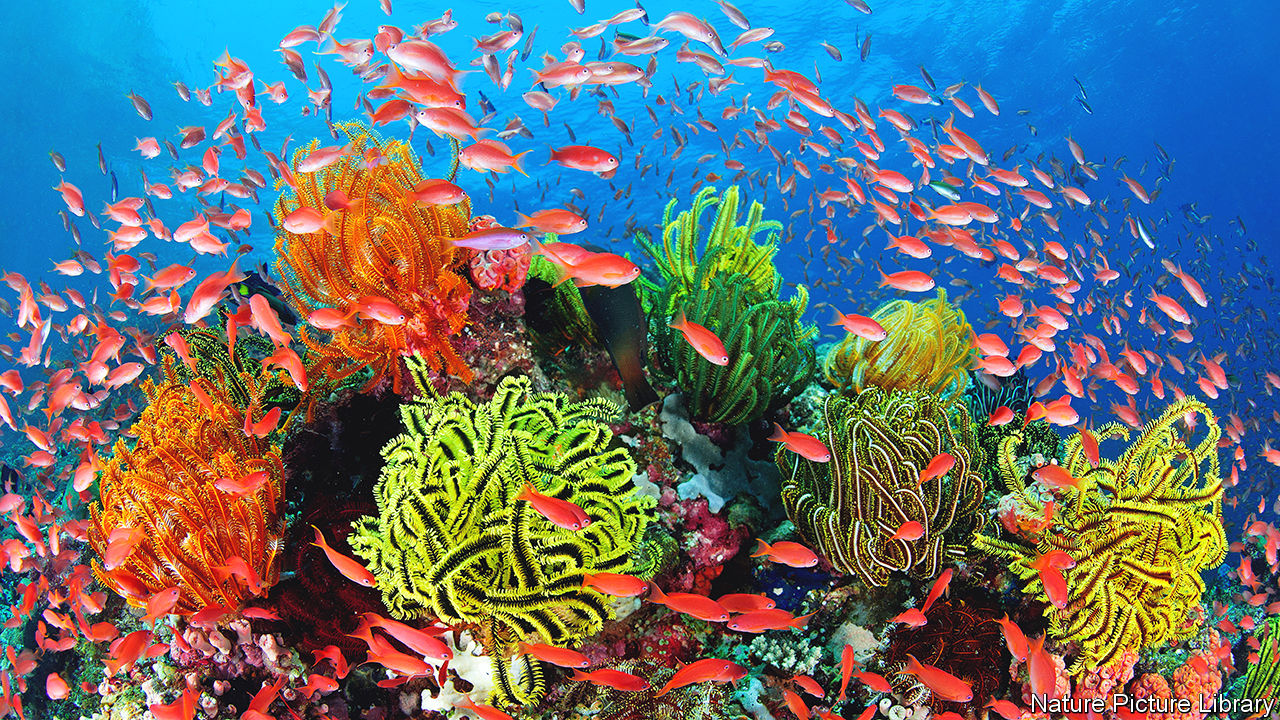Coral reefs are considered to be the “rainforests of the sea” as they are responsible for housing about 25% of the known marine life on Earth (Florida Keys National Marine Sanctuary, n.d.; Knowlton 2001; Wagner et al., 2020). The basic structure on which coral reefs are grown are limestone which is deposited by coral polyps over a period of time (Florida Keys National Marine Sanctuary, n.d.). Like all ecosystems, reefs are exposed and vulnerable to changes in the climate.
As the temperature rises in the oceans due to global warming this has an effect on the coral systems around the world. Coral bleaching occurs where there is a strong variation in temperature (either too high or too low). This causes the algae that has a mutualistic relationship with the coral to exit it causing the white appearance known as bleaching. In addition to this, there is the issue of increasing ocean acidification due to uptake of excess carbon dioxide in the atmosphere. This acidification can be detrimental to the skeletal structure of corals (Mollica et al., 2018). Rising sea levels also means that the tropical corals will, in the future, be at deeper depths. This can have a unfavourable effect on their growth as the mutualistic algae on which the corals depend for survival are reliant on sunlight for photosynthesis. Corals are also exposed to threats such as damage and breaking from dredging, shipping and fishing ventures (Ritchie and Roser, 2021).

How can the corals survive these changes?
Some corals species can already withstand the increasing acidification of the ocean (University of California-Santa Cruz, 2019). At least three species of Caribbean corals have been found to be resilient to ocean acidification at levels which surpass those projected for the next hundred years (University of California-Santa Cruz, 2019). These species of corals and others like them can be used to repopulate areas that have already been or will be negatively impacted by changing sea acidity. The restoration of many coral reef systems has also already been undertaken around the world (United Nations, 2021). Going a step further, with the knowledge of how to grow corals and a basic foundation on which they can grow (for example limestone, sunken ships (Soares et al., 2020) or coral nurseries where the coral is simply suspended in the water) it may even be possible to populate areas where there were previously no corals (Soares et al., 2020). Additionally, there are cold water corals which can survive in darker colder areas of the ocean. These corals can survive at negative temperatures and depths as low as 2000m (Reefcause conservation, 2021). These cold-water corals like their warm water cousins can be grown in colder deeper territories thus circumventing the issue of warming temperatures and rising sea levels.

Coral Nursery. Source: National Ocean Service. (n.d.). “Hope for Corals: Growing Species Resilience in Coral Nurseries.” National Oceanic and Atmospheric Administration (NOAA).
“Playing God”: Necessity or detriment?
Human intervention in the fate of corals may be seen as “playing God” with nature. The introduced reefs may become invasive (Soares et al., 2020) or perhaps may even be disadvantageous to natural life as they may attract parasites, predators or even disrupt the food chain. On the other hand, however, humans have already caused significant negative impacts to the environment (IPCC, 2021) and will continue to do so to various degrees in the foreseeable future. 90% of coral life are at risk of dying out in the next century due to anthropogenic global warming (United Nations, 2021). In a perfect world humans would perhaps share a similar perspective and seek the best interest of the planet they call their home. However, we live in a world of imperfections and uncertainty. As explored in the course “Uncertain climate futures” different countries and institutions in the world have their own outlooks, agendas and priorities when it comes to their treatment of nature and viewpoints about the future of the planet.
The oceans and reefs are a great resource for life not only for humanity, but other living beings on this planet. With the knowledge that these systems are in imminent peril, it may perhaps be too late to stay our hand – we cannot afford not to “play God.” The accelerated acidification, warming and rising sea levels of the ocean are likely to dramatically increase in the future if we allow warming to continually increase due to anthropogenic influence (IPCC, 2021). Marine life dependant on corals are already affected by massive bleaching events in that they lose not only their homes but their sustenance. If we intervene, restore and spread more resilient species of corals perhaps the reliant marine life has a chance to survive and even thrive well into the future.
Bibliography
Florida Keys National Marine Sanctuary. (n.d.). “Coral reefs are massive structures made of limestone deposited by coral polyps.” National Oceanic and Atmospheric Administration (NOAA). Retrieved from https://floridakeys.noaa.gov/corals/coralreef.html
Hughes, T. P., Anderson, K. D., Connolly, S. R., Heron, S. F., Kerry, J. T., Lough, J. M., … & Wilson, S. K. (2018). Spatial and temporal patterns of mass bleaching of corals in the Anthropocene. Science, 359(6371), 80-83.
IPCC. (2021) Summary for Policymakers. In: Climate Change 2021: The Physical Science Basis. Contribution of Working Group I to the Sixth Assessment Report of the Intergovernmental Panel on Climate Change [Masson-Delmotte, V., P. Zhai, A. Pirani, S. L. Connors, C. Péan, S. Berger, N. Caud, Y. Chen, L. Goldfarb, M. I. Gomis, M. Huang, K. Leitzell, E. Lonnoy, J.B.R. Matthews, T. K. Maycock, T. Waterfield, O. Yelekçi, R. Yu and B. Zhou (eds.)]. Cambridge University Press. In Press.
Knowlton, Nancy. (2001). The future of Coral Reefs. Proceedings of the National Academy of Sciences (PNAS). 98 (10) 5419-5425. https://doi.org/10.1073/pnas.091092998
Mollica ,Nathaniel R., Weifu Guo, Anne L. Cohen, Kuo-Fang Huang, Gavin L. Foster, Hannah K. Donald, and Andrew R. Solow. (2018). Ocean acidification affects coral growth by reducing skeletal density. Proceedings of the National Academy of Sciences (PNAS). 115 (8) 1754-1759. https://doi.org/10.1073/pnas.1712806115
National Ocean Service. (n.d.). “Hope for Corals: Growing Species Resilience in Coral Nurseries.” National Oceanic and Atmospheric Administration (NOAA). Retrieved from https://oceanservice.noaa.gov/ocean/corals/hope-for-corals.html
Reefcause conservation. (2021, March 3). “What are cold water coral and why are they important?” Reefcause conservation. Retrieved from https://conservation.reefcause.com/what-are-cold-water-coral-and-why-are-they-important/
Ritchie, Hannah and Max Roser (2021) – “Biodiversity: Coral Reefs”. Published online at OurWorldInData.org. Retrieved from https://ourworldindata.org/biodiversity
Soares, Marcelo de Oliveira, Sula Salani, Sandra Vieira Paiva, Marcus Davis Andrade Braga. (2020). Shipwrecks help invasive coral to expand range in the Atlantic Ocean. Marine Pollution Bulletin. Volume 158, 111394, https://doi.org/10.1016/j.marpolbul.2020.111394.
United Nations. (2021, March 19). “From the Field: Saving corals in crisis” United Nations : UN News. Retrieved from https://news.un.org/en/story/2021/03/1087592
University of California – Santa Cruz. (2019, June 26). “Some corals can survive in acidified ocean conditions, but have lower density skeletons.” ScienceDaily. Retrieved from www.sciencedaily.com/releases/2019/06/190626171230.htm
Wagner D, Friedlander AM, Pyle RL, Brooks CM, Gjerde KM and Wilhelm T‘A .(2020). Coral Reefs of the High Seas: Hidden Biodiversity Hotspots in Need of Protection. Front. Mar. Sci. 7:567428. doi: 10.3389/fmars.2020.567428


Thank you, Varuna, for introducing the case of coral reef futures and discussing it based on many references. While I enjoyed reading about this case, I think the discussion would have benefited from linking it to the term “adaptation”, and associated literature, in addition to the metaphorical “playing God”, which is usually used with a critical intention. A term such as “adaptation” may add some nuance to the black-and-white of “necessity” and “detriment”.
Varuna, it is nice that you have all the information divided into small pieces and thrown in a great lot of crossed links. I personally agree on necessity of manipulating the biodiversity of the oceans by presenting new resilient species of corals. However, it would be also interesting to examine how far we have come in studying the ocean ecosystems in such a way that it gives us the ‘right’ to fix the ecological disaster committed by ourselves.